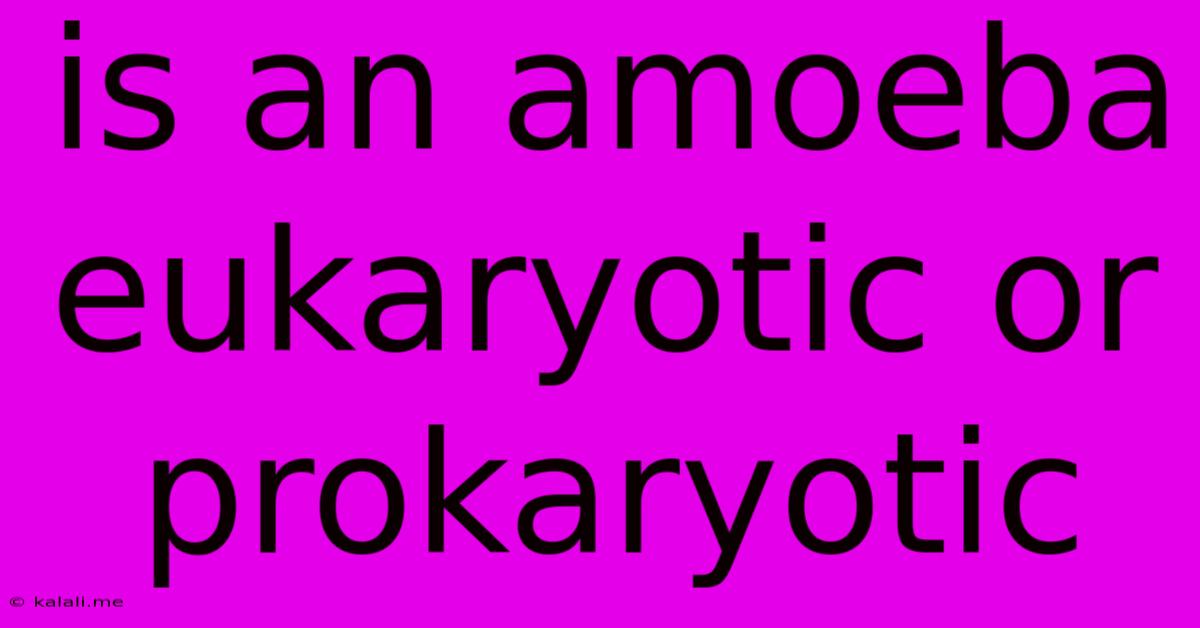Is An Amoeba Eukaryotic Or Prokaryotic
Kalali
May 09, 2025 · 3 min read

Table of Contents
Is an Amoeba Eukaryotic or Prokaryotic? Understanding Cellular Structures
Are you curious about the tiny world of single-celled organisms? Understanding whether an amoeba is eukaryotic or prokaryotic is key to grasping fundamental differences in cellular structure and function. This article will delve into the characteristics of both eukaryotic and prokaryotic cells, ultimately answering the question and highlighting the unique features of amoeba.
Amoebas, those fascinating single-celled organisms often studied in biology classes, are definitively eukaryotic. This means their cells possess a complex internal structure, unlike their prokaryotic counterparts. Let's explore the defining characteristics that differentiate these two cell types.
Prokaryotic Cells: Simple but Efficient
Prokaryotic cells are simpler in structure. They lack a true nucleus and other membrane-bound organelles. Their genetic material (DNA) floats freely in the cytoplasm, a jelly-like substance filling the cell. Bacteria and archaea are prime examples of organisms with prokaryotic cells. Key features of prokaryotic cells include:
- No nucleus: Genetic material is not enclosed within a membrane.
- Smaller size: Generally much smaller than eukaryotic cells.
- Simpler structure: Fewer internal compartments and organelles.
- Single circular chromosome: Their DNA is organized into a single, circular chromosome.
- Ribosomes: These are present, responsible for protein synthesis, but are structurally different from those in eukaryotes.
Eukaryotic Cells: Complexity and Compartmentalization
Eukaryotic cells, on the other hand, are significantly more complex. They possess a membrane-bound nucleus containing their DNA, as well as numerous other membrane-bound organelles, each with specialized functions. This compartmentalization allows for efficient and coordinated cellular processes. Animals, plants, fungi, and protists (like amoebas) all have eukaryotic cells. Key characteristics include:
- Membrane-bound nucleus: The DNA is enclosed within a membrane-bound nucleus.
- Larger size: Generally much larger than prokaryotic cells.
- Numerous organelles: Specialized structures like mitochondria (powerhouses of the cell), endoplasmic reticulum (protein and lipid synthesis), Golgi apparatus (protein processing and packaging), and lysosomes (waste disposal).
- Linear chromosomes: DNA is organized into multiple linear chromosomes.
- Complex cytoskeleton: A network of protein filaments providing structural support and facilitating cell movement.
Amoeba: A Eukaryotic Case Study
Amoebas, belonging to the kingdom Protista, are excellent examples of eukaryotic cells. Their cellular structure exhibits all the hallmarks of eukaryotic complexity. They possess a true nucleus containing their genetic material, along with other organelles crucial for their survival and movement. The presence of a nucleus, along with other membrane-bound organelles, clearly places amoebas in the eukaryotic domain. Their unique method of locomotion, using pseudopods (temporary extensions of the cytoplasm), is also facilitated by their complex cytoskeletal structure – a defining feature of eukaryotic cells.
Furthermore, amoebas exhibit features such as phagocytosis (engulfing food particles) and a contractile vacuole (regulating water balance), processes facilitated by the intricate internal organization only possible in eukaryotic cells. These processes contribute to their survival in diverse environments.
Conclusion: Amoebas are undeniably Eukaryotic
In summary, the presence of a membrane-bound nucleus and other membrane-bound organelles, along with its more complex cellular structure, definitively classifies the amoeba as a eukaryotic organism. Understanding this fundamental distinction is crucial for comprehending the diversity of life and the intricate mechanisms driving cellular function. The amoeba, therefore, serves as a compelling case study illustrating the complexity and efficiency of eukaryotic cell organization.
Latest Posts
Latest Posts
-
28 Degrees Celsius Is What In Fahrenheit
May 09, 2025
-
Cuantas Oz Hay En Una Libra
May 09, 2025
-
Which Lists All Of The X Intercepts Of The Graphed Function
May 09, 2025
-
3 Is What Percent Of 9
May 09, 2025
-
120 Inches Equals How Many Feet
May 09, 2025
Related Post
Thank you for visiting our website which covers about Is An Amoeba Eukaryotic Or Prokaryotic . We hope the information provided has been useful to you. Feel free to contact us if you have any questions or need further assistance. See you next time and don't miss to bookmark.